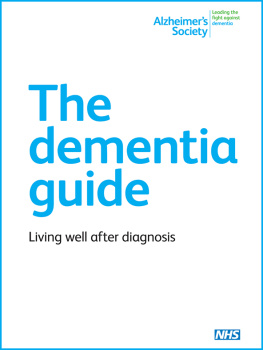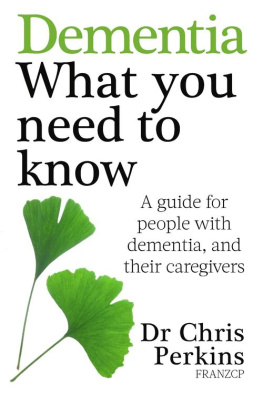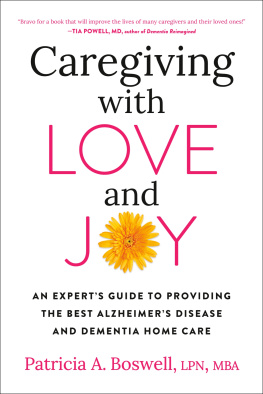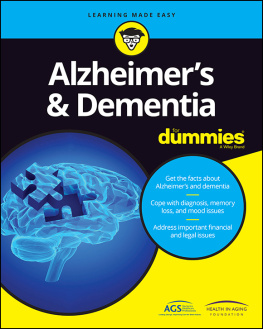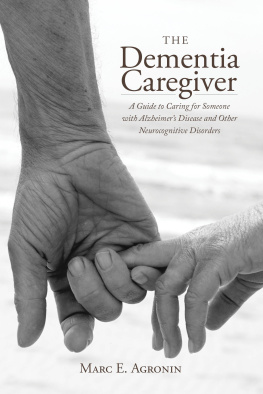I wish to thank the following individuals for their support, enthusiasm, encouragement, invaluable comments, and patience to answer what some would consider too many questions: Libby Golden Hopkins (RN), Edward Fancovic (MD), Elizabeth Roll (PhD), Sam Roll (PhD), Eric Roll, Susan Albright, Mae Green, Lauren Lockett, Dara Lockett, Rocky Stone, Barbara Shapiro, Carla Nichols, Hattie Johnson, Jeanne Johnson, Mary Ann Conley (PhD), and Susan Romano (PhD).
I also wish to thank the numerous families and the individuals in their care who allowed me to intrude into their lives. Their candor helped all of us learn about the difficulties caregivers face and the range of emotions family caregivers experience.
I would be remiss if I did not mention the efforts of doctors Edward Fancovic (MD) and Francesco Standoli (MD). Dr. Fancovic was Dorothys primary caregiver for the last few years of her life. Despite the challenges, he was always patient, informative, and kind. Our family appreciates his efforts in helping to make things run as smoothly as possible.
Dr. Standoli provided Dorothys care during her short stay in an assisted living facility. We will always remember him for his kindness, humor, and ability to gently guide Dorothy through the last stages of her life.
And to our caregiversCarla Nichols, Hattie Johnson, and Jeannie Johnsona thank-you hardly covers what you did for our family. Because of your patience, caring, and humor, too, Dorothy was able to spend all but a few weeks of her life in the home she loved.
And without question, extra special thanks go to Erin Conklin (RN, MSN). The combination of her keen editorial eye, medical experience, and generosity made a nearly overwhelming project doable. And a private joke: thank-you, Betty Crocker.
I would not have survived this unintended journey without the quiet support of my husband, Richard Shagam. He was always there to lend a hand, subdue my frustrations, and offer words of solace. Then, when the demands of dementia care and estate management were over, I spent the next eighteen months writing the first edition of this book. Now, my grateful thanks extend to the ten months it took to write the second edition. All I can say is, What a good guy.
And to my granddaughters Camille and Pauline, both impressed by the pile of paper on my desk and floor, as of tomorrow you will have my full attention.
CHAPTER 1
Schultz, Richard, and Scott R. Beach. Caregiving as a Risk Factor for Mortality: The Caregiver Health Effects Study. Journal of the American Medical Association 282, no. 23 (1999): 2,215. Accessed October 31, 2012. http://jama.jamanetwork.com/article.aspx?articleid=192209.
CHAPTER 2
Schultz, Richard, and Scott R. Beach. Caregiving as a Risk Factor for Mortality: The Caregiver Health Effects Study. Journal of the American Medical Association 282, no. 23 (1999): 2,215. Accessed October 31, 2012. http://jama.jamanetwork.com/article.aspx?articleid=192209.
CHAPTER 3
Alzheimers Association. Lewy Body Dementia. Accessed May 21, 2020. https://www.alz.org/alzheimers-dementia/what-is-dementia/types-of-dementia/lewy-body-dementia.
. Parkinsons Disease Dementia. Accessed May 21, 2020. https://www.alz.org/alzheimers-dementia/what-is-dementia/types-of-dementia/parkinson-s-disease-dementia.
. Stages of Alzheimers. Accessed May 21, 2020. https://www.alz.org/alzheimers-dementia/stages.
. 10 Early Signs and Symptoms of Alzheimers. Accessed May 20, 2020. https://www.alz.org/alzheimers-dementia/10_signs.
. 2018 Alzheimers Facts and Figures. Accessed May 21, 2020. https://www.alz.org/media/documents/facts-and-figures-2018-r.pdf.
. 2019 Alzheimers Facts and Figures. Accessed May 21, 2020. https://www.alz.org/media/documents/alzheimers-facts-and-figures-2019-r.pdf.
Centers for Disease Control and Prevention. CreutzfeldtJakob Disease, Classic (CJD). Accessed May 21, 2020. https://www.cdc.gov/prions/cjd/occurrence-transmission.html.
. U.S. Burden of Alzheimers Disease, Related Dementias to Double by 2060. Press release, September 20, 2018. Accessed March 22, 2021. https://www.cdc.gov/media/releases/2018/p0920-alzheimers-burden-double-2060.html.
Geda, Yonas. Mild Cognitive Impairment in Older Adults. Current Psychiatry Report 14, no. 4 (2012): 32027. Accessed May 20, 2020. https://www.ncbi.nlm.nih.gov/pmc/articles/PMC3963488/.
Janssen. Causes of Dementia. Accessed March 15, 2021. https://www.dementia.com/causes.html.
Mayo Clinic. Huntingtons Disease. Accessed May 21, 2020. https://www.mayoclinic.org/diseases-conditions/huntingtons-disease/symptoms-causes/syc-20356117.
National Organization for Rare Disorders. WernickeKorsakoff Syndrome. Accessed May 21, 2020. https://rarediseases.org/rare-diseases/wernicke-korsakoff-syndrome/.
Price, Richard W. AIDS Dementia Complex. HIV InSite. Accessed May 21, 2020. http://hivinsite.ucsf.edu/InSite?page=kb-04-01-03.
Rahn, Kristen, Barbara Slusher, and Adam Kaplin. Cognitive Impairment in Multiple Sclerosis: A Forgotten Disability Remembered. Cerebrum (NovemberDecember 2012). Accessed May 21, 2020. https://www.ncbi.nlm.nih.gov/pmc/articles/PMC3574761/.
U.S. Department of Veterans Affairs. PTSD: National Center for PTSD. Accessed May 21, 2020. https://www.ptsd.va.gov/understand/related/tbi_ptsd.asp.
Weill Institute for Neurosciences. Behavioral Variant Frontotemporal Dementia. Accessed May 21, 2020. https://memory.ucsf.edu/dementia/ftd/behavioral-variant-frontotemporal-dementia.
. Familial FTD. Accessed May 21, 2020. https://memory.ucsf.edu/genetics/familial-ftd.
CHAPTER 4
Death, John, Adam Douglas, and Rose Anne Kenny. Comparison of Clock Drawing with Mini Mental State Examination as a Screening Test in Elderly Acute Hospital Admissions. Postgraduate Medical Journal 69, no. 815 (1993): 696. Accessed May 7, 2020. http://europepmc.org/backend/ptpmcrender.fcgi?accid=PMC2399767&blobtype=pdf.
Internet Stroke Center. BlessedRoth Assessment Scale. Accessed March 23, 2021. http://www.strokecenter.org/wp-content/uploads/2011/08/blessed_dementia.pdf.
Medical Xpress. Blood Test May Accurately Predict Alzheimers: Study. November 30, 2020. Accessed March 18, 2021. https://medicalxpress.com/news/2020-11-blood-accurately-alzheimer.html#:~:text=Scientists%20said%20Monday%20they%20had,fight%20against%20the%20debilitating%20condition.
National Institute on Aging, U.S. Department of Health and Human Services. Scam Susceptibility May Signal Risk for Cognitive Decline. Published June 6, 2019. Accessed March 25, 2020. https://www.nia.nih.gov/news/scam-susceptibility-may-signal-risk-cognitive-decline.
Office of Civil Rights (OCR), U.S. Department of Health and Human Services. Summary of the HIPAA Privacy Rule. Last reviewed 2013. Accessed May 6, 2020. https://www.hhs.gov/hipaa/for-professionals/privacy/laws-regulations/index.html./for-professionals/privacy/laws-regulations/index.html.
U.S. Census Bureau. Population 60 Years and over in the United States. Accessed April 6, 2021. https://data.census.gov/cedsci/table?q=S0102&tid=ACSST1Y2018.S0102.
CHAPTER 5
American Association of Retired Persons (AARP). Caregiving in the U.S.: 2020 Report. Accessed March 15, 2021. https://www.aarp.org/content/dam/aarp/ppi/2020/05/full-report-caregiving-in-the-united-states.doi.10.26419-2Fppi.00103.001.pdf.
Area Agency on Aging of Pasco-Pinellas (AAAPP). Are You a Caregiver? Accessed May 21, 2020. https://agingcarefl.org/wp-content/uploads/2013/04/Introduction_-_page_1-_12.pdf.
Kreider, Rose M., and Renee Ellis. Living Arrangements of Children: 2009. U.S. Census Bureau, June 2011. Accessed June 2, 2020. https://www.census.gov/prod/2011pubs/p70-126.pdf.


